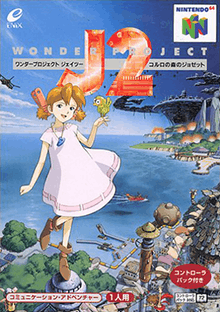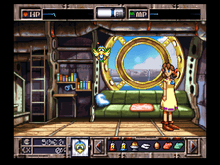Wonder Project J2
Wonder Project J2[lower-alpha 1] is a 1996 life simulation video game developed by Givro Corporation and originally published by Enix for the Nintendo 64. It is the sequel to Wonder Project J, which was released earlier in 1994 for the Super Famicom.
| Wonder Project J2 | |
|---|---|
 Japanese Nintendo 64 cover art | |
| Developer(s) | Givro Corporation |
| Publisher(s) | Enix |
| Director(s) | Takashi Yoneda |
| Producer(s) | Hiroki Fujimoto |
| Designer(s) | Takashi Yoneda |
| Programmer(s) | Hiromitsu Shioya Noriyuki Tomiyama Seiji Kato |
| Artist(s) | Akihiko Yamashita Keiichi Sato |
| Writer(s) | Takashi Yoneda |
| Composer(s) | Akihiko Mori |
| Series | Wonder Project J |
| Platform(s) | Nintendo 64 |
| Release |
|
| Genre(s) | Life simulation |
| Mode(s) | Single-player |
Gameplay

Wonder Project J2 is a bishōjo life simulation game similar to its predecessor, where the player communicates with Josette through her robot, Bird.[1][2] The player answers her questions on-screen by selecting "yes" or "no". Josette cannot hear or see the player, but learns about the player through successive binary questions. She recalls the answers later throughout the story. The player can command Josette through Bird, though she does not always listen. Player advancement through the game is dependent on how well their teachings mesh with other activities on the island. After teaching Josette a series of fundamental human interactions, the plot-driven second chapter guides Josette through a series of hardships and confrontation with the Siliconian Army.
Synopsis
Wonder Project J2 takes place after the events of Wonder Project J.[1] Josette is a girl Gijin (robot) created by Dr. Geppetto, who built Pino 15 years prior. Having just completed Jossette, the aged doctor had little time to raise her, so the player assists. Messala, antagonist of the previous game, receives orders from king Siliconian XIII to "find the girl who lives on the island of Corlo who is in possession of the J", an object of great power cabable of giving Gijin humanity and realize their dreams. Siliconian armies are dispatched to find the girl at Corlo island. Before passing away, Geppetto tells Josette to leave Corlo for Blueland island, where she will meet someone to help her. However, Blueland is occupied by the Siliconian Army harvesting Proton, a mineral fuel source.
Development
Release
Wonder Project J2 was first released for the Nintendo 64 by Enix in Japan on November 22, 1996, packaged with a game-themed Controller Pak.[3][4] Interest about the game was sparked in North America by previews from western publications such as Electronic Gaming Monthly, Next Generation and Nintendo Power, the latter of which featured it in their "Epic Center" section as one of its last appearances before the aforementioned section was discontinued due to lack of role-playing games on Nintendo 64.[5][6][7][8] When asked about a possible North American release from Nintendo by GameFan, then-Nintendo Treehouse member Jim Henrick stated he did not know when it would be published, as Enix ceased distribution of their titles in the region.[9] Though initially planned as a Nintendo 64 exclusive, Enix later announced in 1997 that a PlayStation port with additional animated sequences which would not fit within the memory limitations of the Nintendo 64 Game Pak, however, this version was never released.[10] Despite never being officially published outside Japan, a fan translation was released in 2007.[11][12] Square Enix later re-released the title alongside its predecessor for download on mobile phones in Japan on April 12, 2010.[11][13][14]
Reception
| Reception | ||||||||||||||||
|---|---|---|---|---|---|---|---|---|---|---|---|---|---|---|---|---|
| ||||||||||||||||
Wonder Project J2 received largely positive reviews.[21] Famitsu gave it a score of 33 out of 40.[15] GameSpot gave it a 5.2 out of 10 score.[16] N64 Magazine gave it 55%.[17] 64 Extreme gave it 75%.[18] German magazine Total! praised the game.[22] 1UP.com noted that the 3D sections felt awkward.[23] Nintendo Life strongly praised the game.[24]
Notes
References
- ワンダープロジェクトジェイツー: コルロの森のジョゼット 取扱説明書 (Nintendo 64, JP)
- Loe, Casey (February 1997). "Japan Now - Wonder Project J2". GameFan. Vol. 5 no. 2. Metropolis Media. pp. 112–113.
- "Special Feature: Shoshinkai - Part II". Electronic Gaming Monthly. No. 91. Ziff Davis. February 1997. p. 104.
- "ワンダープロジェクトJ2 コルロの森のジョゼット" (in Japanese). Square Enix. 2020. Archived from the original on 2017-07-21. Retrieved 2020-08-12.
- "Previews - Wonder Project J2 (Nintendo 64)". Electronic Gaming Monthly. No. 88. Ziff Davis. November 1996. p. 54.
- "NG Alphas: Wonder Project J2". Next Generation. No. 24. Imagine Media. December 1996. p. 201.
- "Epic Center - Wonder Project J2". Nintendo Power. No. 96. Nintendo of America. May 1997. pp. 52–53.
- "Pak Watch: E3 Report - The Game Masters". Nintendo Power. No. 99. Nintendo of America. August 1997. pp. 104–105.
- Loe, Casey; Cockburn, Andrew (February 1997). "Japan Now - Interviews". GameFan. Vol. 5 no. 2. Metropolis Media. pp. 108–111.
- "In the Studio". Next Generation. No. 26. Imagine Media. February 1997. p. 34.
- Sahdev, Ishaan (19 April 2010). "Wonder Project J2 Heading To iPhone". Siliconera. Curse LLC. Archived from the original on 2016-09-25. Retrieved 2020-08-12.
- "Community & Home-Brew Retro - Retroscene: Translation News Round-Up - Parlez-Vous Anglais?". Retro Gamer. No. 35. Imagine Publishing. March 2007. p. 98.
- "『ワンダープロジェクトJ2 コルロの森のジョゼット』がiモードで配信開始". Famitsu (in Japanese). Enterbrain. 12 April 2010. Archived from the original on 2010-06-14. Retrieved 2020-08-12.
- Nakano, Shinji (12 April 2010). "スクエニ、iモード「ワンダープロジェクトJ2 コルロの森のジョゼット」 - 携帯電話版オリジナルの会話シーンやイラストを収録して登場". GAME Watch (in Japanese). Impress Corporation. Archived from the original on 2017-08-06. Retrieved 2020-08-12.
- "NEW GAMES CROSS REVIEW: ワンダープロジェクトJ2 〜コルロの森のジョゼット〜 (N64)". Famitsu (in Japanese). ASCII Corporation. 1996. Archived from the original on 2017-04-28. Retrieved 2020-08-12.
- Gerstmann, Jeff (13 March 1997). "Wonder Project J2 (Import) Review - If nothing else, Wonder Project J2 will make you realize just how different the US and Japanese game markets truly are". GameSpot. CBS Interactive. Archived from the original on 2015-11-09. Retrieved 2020-08-12.
- Overton, Wil (April 1997). "Import Arena: Wonder Project J2 - Wanted: Father figure for naive robot girl. No experience necessary". N64 Magazine. No. 1. Future Publishing. p. 89.
- Herridge, Dazza; Saul (July 1997). "Review: Wonder Project J2 - The Japanese have gone 'Control Freak' Crazy! Fancy teaching An innocent and impetuous young girl the facts of life?". 64 Extreme. No. 4. Quay Magazine Publishing. pp. 24–25.
- "Japon Zoom - Zapping - Wonder Project J2". Joypad (in French). No. 61. Yellow Media. February 1997. p. 80.
- Kamikaze, Marcelo (February 1997). "Nintendo 64 - Wonder Project J2". Super Game Power (in Portuguese). No. 35. Nova Cultural. p. 16.
- Seddiki, Reyda (January 1997). "Over the World - Les meilleurs jeux venude l'etranger...: Wonder Project J2 (Nintendo 64)". Player One (in French). No. 71. Média Système Édition. p. 55.
- Yamada, Hirofumi (July 1997). "Test N64: Wonder Project J2". Total! (in German). No. 49. X-Plain-Verlag. p. 58-59.
- Ciolek, Todd (August 6, 2012). "Falls from Grace: How Four Creative Game Companies Went Astray - Givro: Growing Pains". 1UP.com. IGN. Archived from the original on 2012-11-02. Retrieved 2020-08-12.
- Brunskill, Kerry (3 March 2014). "Matters Of Import: Wonder Project J2 Brings Masterful 2D To The N64 - Making cute robots girls cry". Nintendo Life. Nlife Media. Archived from the original on 2015-09-06. Retrieved 2020-08-12.